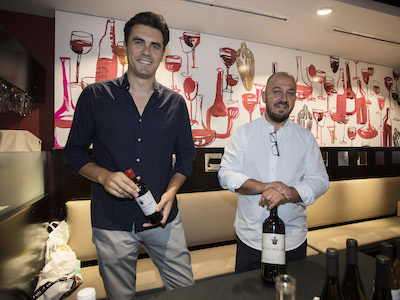
Ramiro Ibáñez and Willy Pérez (Bodegas Luis Pérez) are arguably the most dynamic winemakers in the Sherry Triangle. Beyond running their own acclaimed projects, they share an interest in unravelling and preserving the history of the wines and soils of Jerez—a passion that has been simmering for years in their forthcoming book Los Sobrinos de Haurie.
In 2017 they took their ambitions a step further by recovering the historic and renowned brand Manuel Antonio De la Riva, once owned by a family whose 53 hectares of vineyards lay in Macharnudo. The De la Riva brand was acquired in the 1970s by Domecq, owners of other iconic brands such as Palomino & Vergara, Terry or Agustín Blázquez. After the dismemberment of Domecq, the brand ended in the hands of the multinational Beam Global. Ramiro and Willy now helm its rebirth.
Through this joint project, they seek to recover traditional vinifications and historic pagos (vineyards) such as Balbaína or Macharnudo, where legendary wines such as Fino Tres Palmas, Viña Sabel and Fino La Riva were born.
"We are completely open-minded here," explains Willy. "Even though these wines are fortified, Jerez has always produced great wines, and our wish is to explore styles beyond those of our personal projects". Following Bodegas Luis Pérez’s acquisition of La Escribana and San Cayetano, two estates on the Valcargado hill in Macharnudo, the De La Riva project has reached a new dimension.
Los vinos
With labels that resemble the originals, De La Riva's portfolio blends rare, limited releases with a small selection of regular, annual wines. Together, they reveal a spectrum of styles, terroirs and histories that contribute to understanding the complexity of Sherry, a wine that has undergone many transformations over the centuries.
The regular range include two outstanding unfortified whites. De La Riva El Notario Macharnudo (2,000 bottles, €70), which has been made since the 2016 vintage, and for some vintages now also includes the name of the vineyard on the label; and De La Riva San Cayetano Macharnudo (6,000 bottles, 70 €), the first Spanish white ever sold through the Place de Bordeaux. Depending on the vintage, grapes may be briefly sun-dried to meet the structured style of De La Riva’s historic wines. The wines are then aged in oak butts for around ten months under veil of flor yeast.
The regular range also includes two Manzanillas: Fina de Miraflores Baja (€20) from a quintessential coastal vineyard in Sanlúcar; and Pasada Balbaína Alta (2,500 bottles, €67).
As part of their Almacenista range, Willy and Ramiro are gradually buying soleras to safeguard their survival. "The aim of this project is to have fun and to do things together," explains Willy. It often requires a certain degree of wine archaeology. They frequently have to trace batches from long-defunct wineries and have even rescued butts that were given as payment for debts in the 1980s and have remained untouched ever since.
From this emerge delicate, singular wines, with the finest parcels carefully selected. The bottled releases —extremely limited— are viejísimos: Olorosos, sweet Moscatel and Tintilla, and several palos cortados crafted in the old style, often described as “three or four cortados” due to their extended ageing.
Most popular
NEWSLETTER
Join our community of Spanish wine lovers


